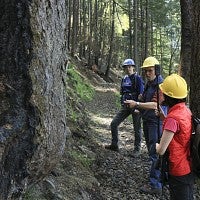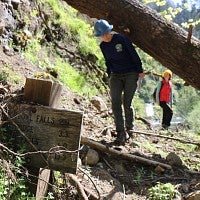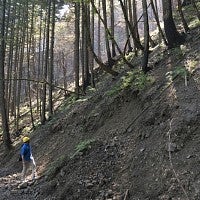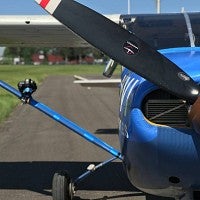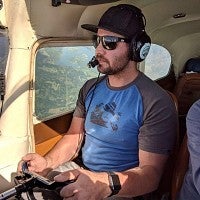It’s been more than a year since the Eagle Creek Fire burned some 48,000 acres of the Columbia River Gorge, devastating a large swath of popular hiking trails and recreational areas. Much of the region will remain inaccessible to the public for years as the forest recovers.
But soon fans of the gorge will be able to visit the restricted area again virtually, thanks to students in the UO School of Journalism and Communication multimedia journalism master’s program. Students enrolled in the program’s 360 video course spent much of the past year capturing scenes of its recovery with immersive storytelling technology.
“There are several aspects of the Eagle Creek Fire that made it a good fit for virtual reality,” said assistant professor Wes Pope, co-director of the program and faculty adviser for the project. “Place-based storytelling and accessibility are key elements of an effective immersive experience.”
To read about other UO research on the fire, see Fire and Slide on the university's homepage.
Establishing place with 360 video
Cassandra Profita is a multimedia journalism master’s student and an environmental reporter with Oregon Public Broadcasting. As a journalist, she wants to give people a way to experience the gorge's recovery, despite the public closures, and better understand the ecological processes that arise in the aftermath of a wildfire.
“I think a lot of people are worried about what it looks like,” she said.
In the spring, representatives from the U.S. Forest Service granted the students supervised access into some of the restricted zones within the burn area. There, the students captured 360-degree video on the ground and in the air with drone-mounted camera rigs.
Profita acknowledges the 360 process is quite different from traditional video reporting, which involves careful shot selection and sequencing. Instead, 360 video allows viewers to “sequence” for themselves, giving them the power to customize the experience.
The class also employed more traditional forms of reporting, including audio and video interviews, explainer videos and photographs. They curated and embedded all this content into a 3D map for a fully immersive educational experience.
Mapping physical spaces with photogrammetry
To create an accurate map, the class captured thousands of overlapping aerial photographs of the burn area and used the software program RealityCapture to stitch them together with a process called photogrammetry.
During the stitching process, the software recognizes subtle changes in the relative positions of objects from one photo to the next. It compiles this data to create a 3D representation that replicates the photographed space or object.
Capturing the still photographs was no small task. It involved flying over the burn area in an airplane with a high-resolution camera attached to a wing strut, following a strict flight pattern at a consistent speed and altitude. To do the flyover, Pope enlisted the help of former multimedia journalism master’s student Brian Burk, now a pilot for flight tourism company Envi Adventures.
Burk and master’s student Lathen Gorbett flew six missions up and down the gorge to capture the thousands of images required to create a 3D map.
“I’ve always wanted to find a way to combine two passions of mine,” Burk said, referring to aviation and photojournalism. He said this experience opened his eyes to the storytelling possibilities an aircraft enables.
Building a virtual world
Once the 3D map was complete, the final phase of production was building the interactive virtual world. Multimedia journalism master’s student Mary Anne Funk led the construction of the map and used a software program called Unity to embed the multimedia assets.
Funk, who works primarily as a visual anthropologist, volunteered her time for the Eagle Creek Fire project to get more practice using immersive storytelling tools. She said she wants to learn these new media so she can better document the lived experiences of the people whose stories she is telling and inspire more empathy in viewers.
“I decided to extend my program out six months past when I would normally be graduating, because I want to learn as much as I can,” she said.
Funk and Pope are teaming up with multimedia journalism master’s student Tony Hernandez, whose final project focuses on the promotion and distribution of the experience. The team worked through summer and fall terms on the virtual world-building and plans to have a working prototype of the Eagle Creek Fire immersive story for test screenings in winter term.
A new lab for immersive storytelling and research
Immersive storytelling research and practice at the UO School of Journalism and Communication is only just beginning.
In October, the school converted a large space at the UO’s Portland campus into the new Oregon Reality Lab, which will be dedicated to the production, post-production, viewing and research of immersive experiences.
When the new multidisciplinary space opens Jan. 10, UO faculty members will begin using it to research immersive media as an ethical tool for social innovation. All UO students are also eligible to register for graduate-level classes in the lab, beginning with Building Communities and Brands in Social Virtual Reality and Designing and Developing Immersive Media in winter term. Pope’s 360 video and photogrammetry courses, in addition to Introduction to Augmented Reality, will be offered spring term.
In the near future, faculty members from across the university as well as Portland-based professionals will be able to use the lab’s technology to develop virtual-, augmented- and blended-reality experiences.
As professional journalists and communicators gradually adopt these budding technologies, Pope sees an opportunity for UO students to get ahead and become leaders in immersive storytelling, both as practitioners and as researchers.
“It is important for universities to play a leading role in helping to understand the potential benefits and ethical areas of concern surrounding this emerging medium,” he said.
—By Jeff Collet, School of Journalism and Communication


